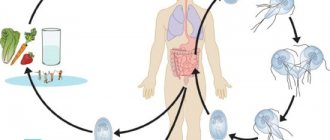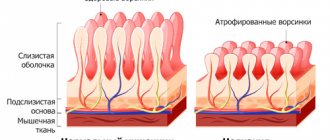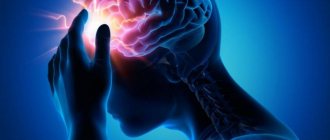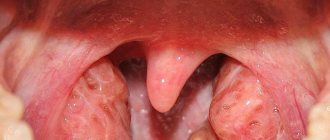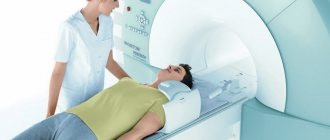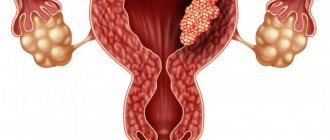Periodically occurring convulsions are not an independent disease; they are symptoms of a number of pathologies of congenital or acquired origin. Involuntary muscle contractions disappear after the underlying cause is eliminated. If seizures are repeated several times during the day and are long-lasting, status epilepticus is assigned to the seizures. This condition is observed in children and adults and can occur periodically throughout life as a reaction of the nervous system to internal and external stimuli.
Difference between episyndrome and epilepsy
Epileptic syndrome is a symptomatic anomaly that accompanies a number of diseases. Manifested by loss of consciousness, tonic-clonic convulsions. In frequent cases, it accompanies epilepsy, but is differentiated from the latter by etiology. A seizure can be triggered by:
- mechanical damage to the brain due to trauma;
- insufficient oxygen supply due to poor circulation;
- intracranial edema or swelling;
- chronic diseases affecting the central nervous system (CNS).
Convulsions may be episodic. When the cause is eliminated, the syndrome disappears along with it.
The anomaly cannot be controlled; attacks occur at any moment of the central nervous system reaction to a particular stimulus. They do not entail negative changes in the brain and do not affect intellectual development.
Epilepsy is a common pathology, affecting 0.6% of the population. Usually manifests itself in infancy, less often in adolescence. It is characterized as a chronic neurological disease, in most cases of unknown origin. Pathology is divided as follows:
- Idiopathic (hereditary). There are precedents when electroencephalography of close relatives in a patient’s family indicated the presence of epilepsy, which they did not suspect, and the anomaly did not manifest itself in any way.
- The essential form occurs against the background of brain damage. In either case, a seizure begins as a result of a sudden over-discharging of neurons in the gray matter that spans the entire brain, causing seizures. Attacks occur repeatedly, they can be controlled by warning signs: nausea, headache.
The difference between episyndrome and epilepsy is as follows:
| Syndrome | Neurological disease |
| symptomatic pathology | independent anomaly of chronic course |
| variety of reasons | genetic predisposition, uncertain etiology, rarely essential (acquired) form |
| uncontrolled manifestation | preceded by an aura (a set of signs) |
| episodic seizures | without adequate therapy, worries throughout life |
| does not cause brain damage | occurs against the background of intracranial negative processes |
The onset of epilepsy in 70% of cases occurs in preschool age. Episyndrome (ES) can first appear in both an adult and a child, it depends on the provoking factor. With a chronic neurological disease, psychological deviations are possible: amnesia, psychosis, sudden changes in mood, depression, impaired mental abilities. The listed symptoms are not characteristic of ES.
Classification
There are two main types of the disease:
- Congenital. Also called primary. Brain structures do not change, although bursts of electrical activity of nerve impulses are still present. The first epileptic seizures occur in childhood or adolescence. They must be distinguished from hysterical attacks, which necessarily occur in the presence of strangers. Congenital epilepsy is regarded as benign because, with the necessary therapeutic intervention, it can be cured.
- Acquired. Another name is secondary (symptomatic). It is associated with pathological processes occurring in brain tissue and the presence of damaging effects. During treatment, medications and procedures are used (only in this case the prognosis can be positive).
A more detailed classification of epilepsy in adults includes several more options.
| Variety | Description |
| Idiopathic (benign) | One of the lightest forms. Treats well under conditions hospital . |
| Generalized | No focal symptoms observed . Characterized by the presence of absence or tonic-clonic seizures, fainting and loss of spatial orientation. |
| Partial | Most widely distributed. The effect appears gradually, spreading from one muscle group to another (in accordance with the order of activation of the nerve centers of the brain). At the same time, the person remains conscious. |
| Jackson's | High probability generalization lesions with their subsequent transformation from simple to complex. |
| Post-traumatic | Pathology occurs as a result of traumatic brain injury. |
| Alcohol-associated | The development is associated with the abuse of alcohol-containing products, which provokes the destruction of cerebral tissue. The pathology may go undetected for decades. |
| Night | The attack occurs during sleep. In this case, a person may bite or swallow his tongue , and urinary and fecal incontinence is observed. |
Regardless of the type of epilepsy, contacting a specialist is mandatory.
Symptoms of episyndrome in children and adults
Signs of an epileptic seizure will depend on the location of the trigger points in the brain. If the excitation zone is in the frontal part, the syndrome is accompanied by:
- sharp tension and stretching of arms and legs, tone of skeletal muscles;
- painful paroxysm of facial muscles;
- chewing reflex, rolling up pupils;
- intense salivation;
- the sensation of non-existent odors.
Damage to the temporal zone manifests itself:
- pain in the lower part of the peritoneum, nausea, possible vomiting;
- hyperthermia;
- visual and auditory hallucinations;
- disorder of consciousness: deja vu (already seen), obsessions, somnambulism;
- gloomy irritability or euphoria.
Symptoms of parietal episyndrome:
- disorientation in space;
- loss of coordination of movements, dizziness;
- numbness of body parts;
- fixation of gaze at one point:
- loss of consciousness.
When the seizure ends, the patient remembers nothing.
The manifestation of the anomaly in infants is more pronounced, this is due to an incompletely formed central nervous system. The onset of episyndrome in children depends on many factors, but it manifests itself almost identically:
- A seizure begins with a loud scream, cessation of breathing, and convulsive muscle contractions.
- The swelling of the fontanel is visually determined.
- The arms are brought to the chest, the muscles are toned.
- The torso is tilted forward, the lower limbs are extended.
- If the pathological process affects the occipital region, rhythmic head nodding, distortion of facial expressions, and the appearance of foam on the lips are observed.
- The attack is accompanied by pain, nausea, vomiting, involuntary urination, and pallor.
In children aged two years and older, sleep may be interrupted by crying and unconscious walking around the room. There is a lack of reaction to external stimuli.
Symptoms of epilepsy
The first noticeable signs of the disease often appear at a young age. It can be:
- motor dysfunction (sudden falls, inability to make purposeful movements, accompanied by screaming, spasms of the glottis);
- pathologies affecting the speech sphere;
- manifestations of muscle hypo- or hypertonicity;
- mental disorders.
Later epilepsy, observed in older people and associated with a gradually worsening weakening of brain function, is much less common.
At any age, pathology can be accompanied by whole groups of symptoms.
| Name of the symptom complex | Description |
| Temporal | Specific symptoms :
|
| Absence |
|
| Rolandic |
|
| Non-convulsive |
|
The severity of the symptoms may depend on the type of nervous activity of the person. However, their character is always equally determined by the area of brain damage.
Some patients suffering from epilepsy (especially with frequent attacks and a long duration of the disease) may develop mental disorders and the following features appear:
- emphasized perseverance;
- accuracy;
- persistence;
- sweetness and obsequiousness;
- psychological toughness;
- rancor.
All of these manifestations are defined as “epileptic in nature.”
Causes of pathology
Whether epileptiform syndrome manifests itself or not depends on the anticonvulsant system. Arousal can be high or low. Activity above the normal threshold in adults is due to:
- insufficient oxygen transport to the brain;
- previous head injuries;
- severe blood loss;
- degenerative abnormalities;
- inflammatory processes, abscesses of the membranes of the intracranial and spinal region;
- disorders of blood sugar metabolism;
- dysfunction of the parathyroid gland;
- narrowing of the lumen of blood vessels (ischemia), myocardial damage (stroke);
- taking medications (antidepressants, sedatives, bronchodilators);
- alcohol and drug abuse;
- intoxication with heavy metals (lead, mercury);
- stressful environment (excitement, fear, loss of a loved one);
- genetic predisposition;
- the formation of blood clots.
In children, an epileptic seizure occurs due to:
- birth trauma of the skull;
- heredity;
- past infectious diseases of the brain during the perinatal period and after;
- raising body temperature above 38 degrees;
- spasmophilia;
- calcium and potassium deficiency;
- asphyxia;
- congenital defects of the central nervous system.
Possible genesis of the syndrome may be hormonal imbalance, pathologies of the cardiovascular system, or poisoning. Light glare, loud sounds, and fear can provoke convulsions.
General information
Epilepsy in adults is a fairly common disease. According to statistics, about 5% of the world's population have suffered an epileptic seizure at least once in their life. However, a single seizure does not warrant a diagnosis. In epilepsy, seizures are repeated with a certain frequency and occur without the influence of any external factor.
Many of us have seen a situation where a person suddenly loses consciousness, falls to the ground, convulses and foams at the mouth. This variant of an epileptic seizure is only a special case; in terms of its clinical manifestations, seizures are much more diverse. The seizure itself can be an attack of motor, sensory, autonomic, mental, visual, auditory, olfactory, and taste disturbances with or without loss of consciousness.
Treatment
Epileptic syndrome is a set of symptoms characteristic of a particular disease. Therefore, therapy is aimed at stopping the underlying pathology and relieving symptoms. The complex of effects on the anomaly includes medications, herbal medicine, neurosurgical intervention, diet, and physical procedures.
First aid
If during an attack a person is conscious and can control his actions, no immediate measures are required. When convulsions occur against the background of respiratory arrest, severe salivation and the patient’s unconscious state, urgent intervention is necessary. Algorithm of actions:
- Give your torso a horizontal position.
- Place a soft cushion under your head and turn your face to the side.
- Unclench your teeth, fix your tongue with a spatula or spoon.
- Provide access to oxygen (loosen the collar of the clothing).
- If necessary, if the attack lasts more than 5 minutes, call a doctor.
Timely assistance will help prevent tongue biting, hypoxia, and head and body injuries.
Review of drugs
The main emphasis in conservative treatment is on the use of:
- Anticonvulsants that relieve partial and generalized spasms: Ethosuximide, Topiramate, Levetiracetam, Lamotrigine, valproates based on valproic acid.
- Psychotropic drugs that normalize the functioning of the central nervous system: Phenibut, Bromcamphor mixture, Barbamil, Valosedan.
- Neurotropic drugs acting on the area of excitation in the central nervous system: Dibazol, Tetrazepam, Sibazon.
- Nootropic drugs that have a calming effect: Bromazepam, Elenium, Atarax.
The duration of use is from a year or more, depending on the frequency and intensity of seizures.
Non-drug methods
To enhance the effectiveness of drugs, a number of measures are included in complex treatment:
- Vojta physiotherapy is a therapy that affects motor reflexes and is indicated for patients with motor impairment.
- Neurostimulation of the vagus nerve (the link between the body and the brain) with electrical impulses. The technique is called VNS therapy; it inhibits activity at trigger points.
- The ketogenic diet (low-carbohydrate) consists of high-fat foods and reduces protein intake.
Herbal medicine for the treatment of ES offers a tincture of a collection consisting of hoofed grass, violet, tansy, valerian, and mistletoe. Two tablespoons of medicinal plants are poured into a thermos with 0.5 liters of boiling water. Leave for 5 hours and take throughout the day.
If the cause of the syndrome is a brain tumor or conservative treatment does not produce positive dynamics, surgical techniques are resorted to.

